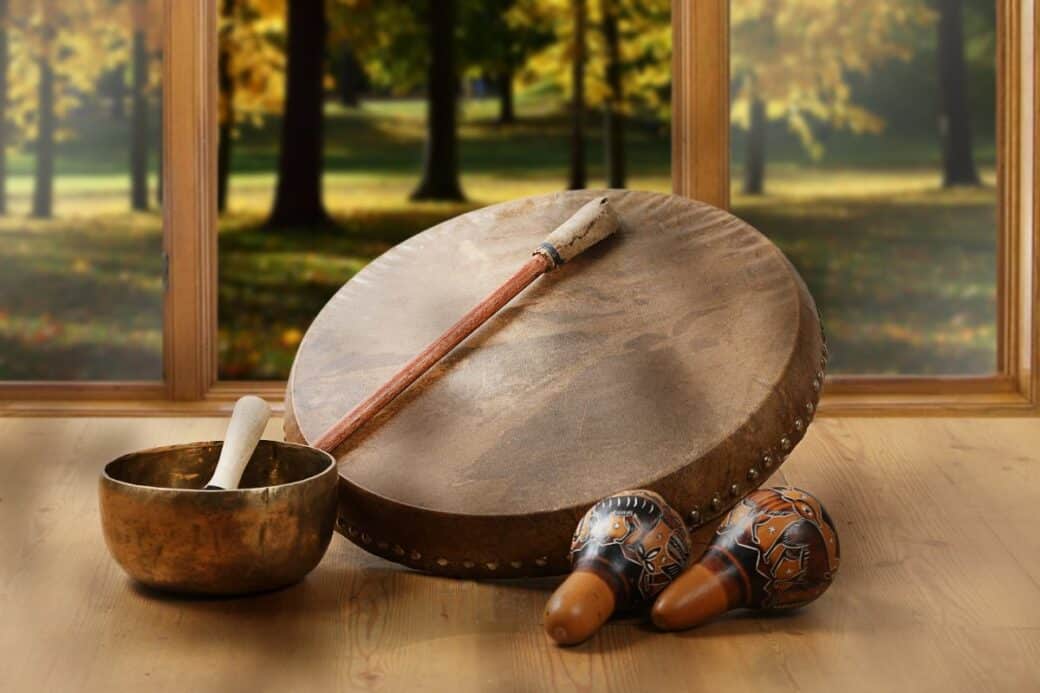Are you ready to unlock your hidden talent and embark on a musical journey? In this article, we explore the fascinating world of singing bowls and ponder the age-old question – is a singing bowl truly an instrument? Join us as we delve into the enchanting history, captivating sounds, and therapeutic effects of these mystical creations. Whether you’re an aspiring musician or simply curious about the power of sound, discover how a singing bowl can ignite your creative spirit and awaken your inner musician. Get ready to be inspired!

Is A Singing Bowl An Instrument: Understanding the Singing Bowl
Did you know that a singing bowl is not just a decorative item but actually a musical instrument? If you’ve ever been intrigued by these beautiful bowls and wondered how they work, their origin, or even how to play them yourself, then you’ve come to the right place! In this comprehensive article, we will dive into the world of singing bowls and explore their fascinating history, structure, materials, playing techniques, types, tuning and care, healing capabilities, cultural significance, and even crafting your very own singing bowl. So get ready to embark on a journey of discovery and unleash your inner musician with the melodious sound of a singing bowl.
The Origin of Singing Bowls
Singing bowls have a rich heritage that dates back thousands of years. Originating in the Himalayan regions, particularly Tibet, Nepal, and Bhutan, these bowls have been an integral part of various spiritual and cultural practices. Traditionally used in Buddhist and Bon religious ceremonies, singing bowls have also gained popularity in other parts of the world for their soothing and therapeutic qualities. As we explore the history of singing bowls, we will uncover the significance these mystical instruments hold in different cultures and their transformation into a global phenomenon.
Basic Structure of a Singing Bowl
Before we delve into the mesmerizing sounds of a singing bowl, it’s important to understand its basic structure. A typical singing bowl consists of three main components: the bowl itself, a striker or mallet, and a cushion or pad. The bowl is usually made of metal, either bronze or a combination of different metals, and features a smooth curved shape with a rim that tapers inward. The striker, which is used to create sound, can be made of wood or covered with fabric or leather. The cushion, placed beneath the bowl, helps stabilize it and enhances the resonance. By familiarizing yourself with the anatomy of a singing bowl, you’ll be better equipped to explore its sonic capabilities.
Material Composition of Singing Bowls
The materials used in the construction of singing bowls greatly impact their sound quality and overall performance. Traditional Tibetan singing bowls are primarily made from an alloy of seven metals, each representing celestial bodies: gold (Sun), silver (Moon), mercury (Mercury), copper (Venus), iron (Mars), tin (Jupiter), and lead (Saturn). This unique combination creates a harmonious blend of tones and vibrations. Similarly, crystal singing bowls are crafted from pure quartz crystal, known for its clarity and resonance. Understanding the material composition of singing bowls will not only help you appreciate their craftsmanship but also guide you in selecting the right type of bowl for your musical needs.
Singing Bowls as Musical Instruments
Are singing bowls merely objects of beauty or do they serve a purpose as musical instruments? Let’s explore the musicality of these remarkable bowls, discovering how they create sound and their role in both traditional and contemporary music.
How Singing Bowls Create Sound
The enchanting sound produced by a singing bowl is a result of the interplay between the striker and the bowl itself. To create sound, you need to hold the bowl firmly in one hand and gently strike its rim with the striker or mallet. This action sets the bowl into motion, causing it to vibrate and produce a deep, resonant tone. However, the sound doesn’t stop there! As the bowl continues to vibrate, it emits a sustained harmonic sound that is unique to each individual bowl. This sustained sound is what gives singing bowls their characteristic and melodious quality.
Role of Singing Bowls in Traditional Music
In addition to their significance in religious ceremonies, singing bowls have been an integral part of traditional music in the Himalayan regions. From accompanying chants and mantras to enhancing meditation and spiritual practices, these bowls bring a distinct musicality to the cultural fabric of the region. Discover the traditional musical contexts in which singing bowls are used and gain insight into the spiritual and cultural significance they hold for those who incorporate them into their musical expressions.
Singing Bowls in Contemporary Music
While singing bowls have deep roots in traditional music, they have also carved a niche for themselves in contemporary music genres. Musicians and composers from various cultures have embraced the unique tonal qualities and rich harmonics of singing bowls, incorporating them into their compositions. From ambient and world music to avant-garde and experimental genres, explore how singing bowls have found their way into the contemporary music scene and continue to captivate audiences with their ethereal sound.

Techniques for Playing the Singing Bowl
Now that we understand the musical potential of singing bowls, let’s dive into the playing techniques that allow you to unlock their mesmerizing sound. Whether you’re a beginner or a seasoned player, there are a few fundamental techniques that form the foundation of playing a singing bowl. We’ll explore the hold and strike technique, where you learn the proper grip and striking motion to create sound. Additionally, we’ll delve into the circumambulation technique, a more advanced method that involves using the striker to glide along the rim of the bowl, producing a continuous and enchanting sound. Along the way, we’ll address common challenges faced by players and provide tips and techniques to overcome them, enabling you to create beautiful music with your singing bowl.
The Hold and Strike Technique
The hold and strike technique is the most basic and fundamental way of playing a singing bowl. To begin, hold the base of the bowl firmly in your non-dominant hand, ensuring that your palm is flat against the bottom and your fingers securely grasp the sides of the bowl. Next, take the striker or mallet in your dominant hand, ensuring a comfortable yet firm grip. With a gentle but deliberate motion, strike the rim of the bowl using either the padded end of the striker or the wooden end. Adjust the intensity and angle of the strike to manipulate the volume and tone of the sound produced. The hold and strike technique serves as the building block for more advanced playing techniques, allowing you to develop a strong foundation for exploring the versatility of your singing bowl.
The Circumambulation Technique
Once you have mastered the hold and strike technique, you can further enhance your playing skills by learning the circumambulation technique. This technique involves using the striker to glide along the rim of the bowl, creating a continuous and mesmerizing sound. To execute this technique, place the bowl on a stable surface or cushion and hold the striker parallel to the rim, allowing it to make contact with the bowl’s surface. Apply gentle but consistent pressure as you move the striker in a circular motion around the rim. Experiment with different speeds and pressures to achieve various tonal qualities and explore the unique harmonics produced by your singing bowl. With practice, you will become proficient in utilizing the circumambulation technique, adding depth and complexity to your musical expression.
Overcoming Common Challenges in Bowl Manipulation
As with any musical instrument, mastering the art of playing a singing bowl comes with its fair share of challenges. Common issues faced by beginners include difficulty in producing a clear and resonant sound, inconsistent volume and tone, and insufficient control over harmonics. However, with patience, practice, and a few helpful tips, these challenges can be overcome. Make sure to strike the bowl at the right angle and with the appropriate amount of force to achieve a clear and sustained sound. Experiment with different types of strikers and cushions to optimize your playing experience. Explore the impact of hand position, pressure, and speed on the sound produced, allowing you to create a harmonious and melodious symphony with your singing bowl.
Exploring Different Types of Singing Bowls
Singing bowls come in a variety of types, each with its own unique characteristics and sonic properties. Let’s compare and contrast Tibetan singing bowls and crystal singing bowls, identify the quality of singing bowls, and guide you in choosing the right type of bowl to suit your musical preferences.
Comparison: Tibetan Singing Bowls and Crystal Singing Bowls
Tibetan singing bowls and crystal singing bowls may appear similar at first glance, but they differ significantly in terms of their material composition, sound production, and overall aesthetic. Tibetan singing bowls, as mentioned earlier, are made from a combination of metals that produce rich and complex harmonics. They have a warm and earthy sound that resonates deeply within the listener. On the other hand, crystal singing bowls are crafted from pure quartz crystal, resulting in a clear and vibrant tone that is reminiscent of the chiming of crystal glass. By understanding these differences, you can make an informed decision when selecting a singing bowl that aligns with your musical preferences.
Identifying the Quality of Singing Bowls
When purchasing a singing bowl, it’s important to be able to identify the quality of the instrument to ensure you are getting the best possible sound and craftsmanship. Several factors contribute to the overall quality of a singing bowl, including the composition of the materials used, the thickness and smoothness of the bowl’s walls, and the clarity and sustain of the sound it produces. By observing the bowl’s physical attributes and testing its sound, you can gauge its quality and authenticity. Familiarize yourself with these key indicators and empower yourself to make an informed decision when investing in a singing bowl.
Choosing the Right Type of Singing Bowl for You
With the wide array of singing bowls available, it’s essential to choose the right type that resonates with your musical preferences and personal needs. Consider factors such as the tone, timbre, and resonance of the bowl, as well as the intended use and environment in which you plan to play it. Are you looking for a bowl that promotes relaxation and meditation? Or are you more inclined towards creating experimental and avant-garde music? By understanding your musical goals and preferences, you can narrow down your options and select a singing bowl that will truly inspire and captivate you.
Tuning and Care of Singing Bowls
Once you have acquired your singing bowl, it’s important to tune and care for it properly to ensure that it continues to produce optimal sound quality and longevity. Discover the techniques for identifying the correct pitch and tone of your singing bowl, learn how to perform routine maintenance, and explore strategies for preserving its longevity.
Identifying the Correct Pitch and Tone
Each singing bowl possesses its own unique pitch and tone. Identifying these characteristics is crucial for harmonizing the bowl with other instruments or creating a desired sonic atmosphere. To determine the pitch, run the striker along the rim of the bowl and pay attention to the sound produced. Experiment with different striking points and observe how they affect the tone. By developing an ear for pitch and tone, you’ll be able to better utilize your singing bowl in various musical contexts and enhance your overall playing experience.
Routine Singing Bowl Maintenance
Proper maintenance is key to ensuring the longevity and sound quality of your singing bowl. Regular cleaning and upkeep will help remove dust, grime, and any unwanted residue that may accumulate on the bowl’s surface and affect its resonance. Cleaning your bowl with a soft cloth or brush and using mild soap or specialized cleaning solutions will help maintain its beautiful appearance and sonic clarity. Additionally, storing your bowl in a safe and dry location will protect it from damage and ensure it remains in optimal playing condition. By incorporating routine maintenance into your musical practice, you can keep your singing bowl in pristine condition for years to come.
Preserving the Longevity of Your Singing Bowl
Taking steps to preserve the longevity of your singing bowl is essential to maintain its beautiful sound and craftsmanship. Avoid exposing your bowl to extreme temperatures or sudden changes in temperature to prevent potential cracks or warping. When transporting or storing your bowl, take care to pack it securely to prevent any accidental damage. Finally, practice mindful playing techniques and handle your singing bowl with care to minimize the risk of any accidental impact. By being proactive in preserving the longevity of your singing bowl, you will be able to enjoy its enchanting sounds for many years to come.
The Healing Power of Singing Bowls
Singing bowls have long been associated with healing and therapeutic qualities. Whether used in meditation, yoga, or sound therapy, these instruments have the ability to create a sense of calm, balance, and rejuvenation. Explore the profound effect of singing bowls in promoting mindfulness and focus, enhancing emotional well-being, and cultivating creativity and musical appreciation.
Singing Bowls in Meditation and Yoga
In meditation and yoga practices, singing bowls are often used as a tool to facilitate relaxation, focus, and inner peace. The gentle and resonant tones emitted by these bowls create a soothing atmosphere, helping to quiet the mind and deepen the meditative experience. By incorporating singing bowls into your meditation and yoga routines, you can enhance your overall sense of well-being and encourage a deeper connection with yourself.
Sound Therapy and Singing Bowls
Sound therapy, also known as sound healing or vibrational therapy, utilizes the therapeutic properties of sound to promote healing and balance within the body and mind. Singing bowls are an integral part of this practice, as their vibrations are believed to harmonize and restore imbalances in the energy system. By immersing oneself in the resonant and soothing sounds of singing bowls, individuals can experience stress reduction, increased relaxation, and overall well-being. Discover the transformative power of sound therapy and explore the potential healing benefits that singing bowls can offer.
Scientific Studies on Singing Bowls’ Health Benefits
The healing effects of singing bowls extend beyond anecdotal evidence, as scientific studies have also been conducted to explore their health benefits. Research has shown that the vibrations produced by singing bowls can have a positive impact on the nervous system, promoting a sense of calm and reducing anxiety. Additionally, the harmonious sounds emitted by these bowls can induce a state of relaxation, reducing heart rate and blood pressure. As the field of sound therapy continues to evolve, scientific studies provide further validation of the healing potential of singing bowls, offering a bridge between ancient wisdom and modern understanding.
Singing Bowls in Different Cultures
Singing bowls have not only endured in their traditional roots but have also found their way into various cultures across the globe. Let’s take a closer look at the role of singing bowls in Buddhist traditions, their presence in other religious and cultural practices, and their symbolic significance in art and popular culture.
The Role of Singing Bowls in Buddhist Traditions
Singing bowls have been an integral part of Buddhist rituals and practices for centuries. In Buddhist traditions, these bowls are used for meditation, prayers, chanting, and other sacred ceremonies. The resonant sound produced by singing bowls is believed to evoke a sense of spiritual awakening, enlightenment, and deep introspection. Explore the role of singing bowls in Buddhist rituals and gain insight into the profound influence these instruments have on the spiritual journey of practitioners.
Singing Bowls in Other Religious and Cultural Practices
Beyond their use in Buddhist traditions, singing bowls have also made their way into various religious and cultural practices around the world. They have been incorporated into Hindu rituals, Shamanic ceremonies, and New Age spirituality, among others. Each culture has its unique approach to using singing bowls, incorporating them into their respective belief systems and customs. Discover the diverse ways in which singing bowls are utilized across cultures, broadening your understanding of the universal appeal and significance of these captivating instruments.
Singing Bowls as Symbols in Art and Popular Culture
Singing bowls have transcended their religious and cultural backgrounds to become symbols in art and popular culture. From their presence in paintings and sculptures to their representation in literature and film, singing bowls have captured the imaginations of artists and creatives across the world. They have come to symbolize tranquility, balance, and spiritual harmony, serving as a visual and auditory muse for global audiences. Explore the artistic and symbolic interpretations of singing bowls in various forms of artistic expression, allowing you to appreciate their beauty and cultural significance from a different perspective.
Learning to Play the Singing Bowl
Now that we have explored the various aspects of singing bowls, it’s time to embark on your own musical journey by learning to play this captivating instrument. Whether you’re a beginner looking to acquire the basic skills or a seasoned player interested in mastering advanced techniques, there are valuable resources and courses available to guide you through the process of skill development.
Basic Training for Beginners
If you’re new to playing the singing bowl, it’s essential to start with the basics. Consider seeking out beginner-friendly resources such as instructional books, online tutorials, or even in-person classes to familiarize yourself with the fundamentals of playing a singing bowl. These resources will provide step-by-step guidance on proper playing techniques, hand positions, and care for your instrument. By investing time and effort into acquiring these foundational skills, you’ll build a solid musical groundwork and set yourself up for continued growth and exploration.
Advanced Techniques for Seasoned Players
For those who have already mastered the basics of playing a singing bowl, there are numerous advanced techniques waiting to be explored. Consider delving into advanced playing techniques such as harmonics, overtone singing, and resonance manipulation. These techniques allow you to further expand your musical expression and create complex and captivating sounds with your singing bowl. Additionally, attending workshops or collaborating with professional musicians can offer invaluable insights and inspiration for developing your advanced playing skills. Embrace the journey of continuous learning and evolution, and enrich your musical practice with the nuances and intricacies of advanced singing bowl techniques.
Valuable Resources and Courses for Skill Development
Thanks to the rise in popularity of singing bowls, there is a wealth of resources and courses available to support your skill development. From online platforms offering comprehensive tutorials and workshops to local music schools and community centers, you can find a range of options tailored to your learning preferences. Consider exploring these resources and courses to access professional guidance, connect with fellow enthusiasts, and further enhance your singing bowl playing abilities. Remember, the journey of musical growth and exploration is as unique as the sound of your singing bowl, so embrace the opportunities available to you and continue to cultivate your musical talents.
Crafting Your Own Singing Bowl
If you’re feeling particularly adventurous and creative, why not try your hand at crafting your very own singing bowl? Engaging in the craftsmanship of a singing bowl allows you to develop a deeper appreciation for the artistry behind these instruments and provides you with a personalized and unique musical experience.
Understanding the Art of Singing Bowl Craftsmanship
Crafting a singing bowl requires a deep understanding of the traditional techniques and the meticulous approach that goes into its construction. Every step, from selecting the appropriate materials to shaping and tuning the bowl, demands precision, skill, and attention to detail. By studying the art of singing bowl craftsmanship, you will gain a profound appreciation for the craftsmanship and craftsmanship that goes into creating these resonant masterpieces.
Materials Needed for DIY Singing Bowls
To embark on the journey of crafting your own singing bowl, you will need a few essential materials. The primary component is the metal or crystal used to form the bowl, with traditional singing bowls requiring a mix of various metals while crystal bowls are created from quartz crystal. Additionally, you’ll need specialized tools such as hammers, anvils, and molds to shape and tune the bowl. Depending on the specific crafting technique you choose, additional materials may be required. As with any DIY project, it’s important to ensure the safety of yourself and those around you, so be sure to follow appropriate safety guidelines and precautions.
Troubleshooting Common Crafting Challenges
As you embark on crafting your own singing bowl, you may encounter various challenges along the way. These could include difficulties shaping the metal or crystal, achieving the desired pitch or resonance, or addressing any imperfections that arise during the crafting process. It’s important to approach these challenges with patience and perseverance, learning from any setbacks and making adjustments as necessary. Additionally, seeking guidance from experienced craftsmen or participating in specialized workshops can provide valuable insights and solutions to troubleshoot common challenges that arise during the crafting of a singing bowl.
Impact of Singing Bowls on Personal Growth
Beyond the melodic tones and artistic expressions, singing bowls have the potential to impact personal growth positively. Let’s explore how these magical instruments can improve mindfulness and focus, enhance emotional well-being, and cultivate creativity and musical appreciation.
Improving Mindfulness and Focus
The soothing and resonant sounds of singing bowls have been found to promote mindfulness and focus. By immersing oneself in the sound of a singing bowl, individuals can experience a state of deep presence, where distractions fade away, and clarity of thought emerges. The rhythmic vibrations and harmonious tones serve as a focal point, guiding individuals into a state of inner peace and heightened awareness. Incorporating singing bowls into mindfulness practices such as meditation or even daily rituals can help cultivate a sense of mental clarity and present-moment awareness.
Enhancing Emotional Wellbeing
Sound has the power to evoke powerful emotions and connect with our deepest feelings. The beautiful and harmonious tones produced by singing bowls can evoke a range of emotions, from tranquility and relaxation to joy and serenity. By intentionally incorporating these sounds into your daily life, you can create a healing space where emotional well-being is nurtured. Whether you use singing bowls as part of a self-care routine or as a way to facilitate emotional release, their therapeutic qualities can have a profound impact on your overall emotional health.
Cultivating Creativity and Musical Appreciation
Playing a singing bowl allows for a unique form of creative expression and helps foster a deeper appreciation for music. As you experiment with different techniques, explore various tonal qualities, and create harmonious melodies, you engage in a creative process that encourages spontaneity, exploration, and self-expression. Furthermore, by immersing yourself in the sound of singing bowls and embracing their unique sonic qualities, you develop a heightened appreciation for the intricacies of music and its ability to evoke emotions and connect with the human experience. The combination of musical exploration and appreciation allows you to develop a well-rounded and enriched relationship with the world of music.
Singing bowls are truly remarkable instruments that offer a vast range of experiences and possibilities. Whether you’re drawn to their calming and spiritual qualities, their potential for healing and therapy, or their ability to create captivating and resonant sounds, there is a place for everyone in the world of singing bowls. So, embrace the opportunity to unleash your inner musician and dive into the enchanting world of singing bowls – a world that promises to add beauty, tranquility, and musicality to your life.




